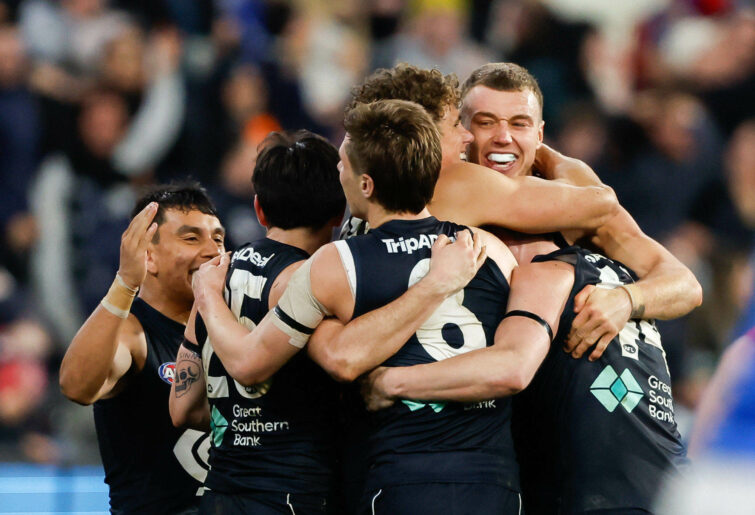'It was unacceptable': Michael Voss slams Blues defence in Geelong loss
The Carlton coach conceded that his side struggled to stop Geelong from scoring when they entered their forward 50, which is not good enough…
Carlton had one of the weirdest seasons in history in 2023. They lost eight out of nine games between Round 5, when Adelaide thumped them, and Round 13 when their most hated rival Essendon beat them. They then won the next nine in a row.
Every time someone from Carlton speaks to the media it seems they say the main changes were defensive pressure and contested football. But did that actually drive the change between good and bad?
Fans at the losing streak will recall Carlton typically worked hard defensively but were borderline unwatchable when they had the ball.
Did defensive pressure and contested football result in the more free-flowing team we saw in the back half of the year? Or was it something else? This article attempts to explain by looking at the median of key team statistics of both the losing streak and the winning streak.
Starting with what Carlton said drove the change, it is clear that defensive pressure increased significantly during the winning streak. Tackles, a proxy for this, were 20 per cent higher in the winning streak compared to the losing streak. Players like Lachie Fogarty and David Cuningham, who came into the side for the winning streak, can take some credit for this, especially from a forward line perspective. Perhaps surprisingly, one-percenters were identical in both the losing and winning streaks.

(Photo by Dylan Burns/AFL Photos via Getty Images)
Carlton also improved its contested football during the winning streak, with clearances up 14 per cent and contested possessions up 6 per cent.
What stands out, though, is that its uncontested football went backwards at the same rate, with uncontested possessions declining 7 per cent in the winning streak. This appears to be a conscious change in strategy to dial back the slow, tortured football of the losing streak.
Linking with the above, Carlton had about the same amount of kicks during both streaks but handballed 8 per cent less during its winning streak. As a proportion, Carlton was kicking more and moving the ball faster.
Further highlighting this, rebound 50s were up 11 per cent. Brodie Kemp added some more mobility as a third tall defender, which assisted the likes of Adam Saad, Jacob Weitering, Mitch McGovern, Nic Newman, Blake Acres and Sam Docherty – Calton’s main rebounders.
The result of this change in ball movement led to probably the biggest change between a good and bad Carlton: efficiency.
Carlton kicked six extra goals a match during the winning streak despite having basically the same number of disposals, 14 per cent less contested marks per game and only marginally more inside 50s than the losing streak.
Marks inside 50 went from 9 per game to 13, a result of the faster ball movement ahead.
Maybe because Carlton were getting more marks inside 50, resulting in easier shots, Carlton’s goalkicking average went from 47 per cent in the losing streak to 61 per cent in the winning streak. This stat alone may explain the difference between a good and bad Carlton most clearly. The increase in accuracy could be a reversion to normality or a result of luck. It may only partially be due to a change in strategy.
Putting it all together it’s clear Carlton improved its contested football and defensive pressure. What’s also clear is Carlton changed its ball movement. They kicked more as a proportion of overall disposals, and cut back on slow uncontested football. Probably the biggest factor was plain old kicking for goal, which could be explained by a combination of faster ball movement resulting in easier shots for goal and random factors such as luck and player confidence.
So what happens in 2024? Given Carlton’s personnel with Patrick Cripps, Adam Cerra, Sam Walsh and George Hewitt, they should control contested possession in most games. The harder item to pick is the quality of the ball movement.
If you’re a Carlton fan you should be hoping games look frantic, not slow and structured. The Blues need speed on the ball and must ensure their conversion in front of goal is closer to 60 per cent than 50 per cent.